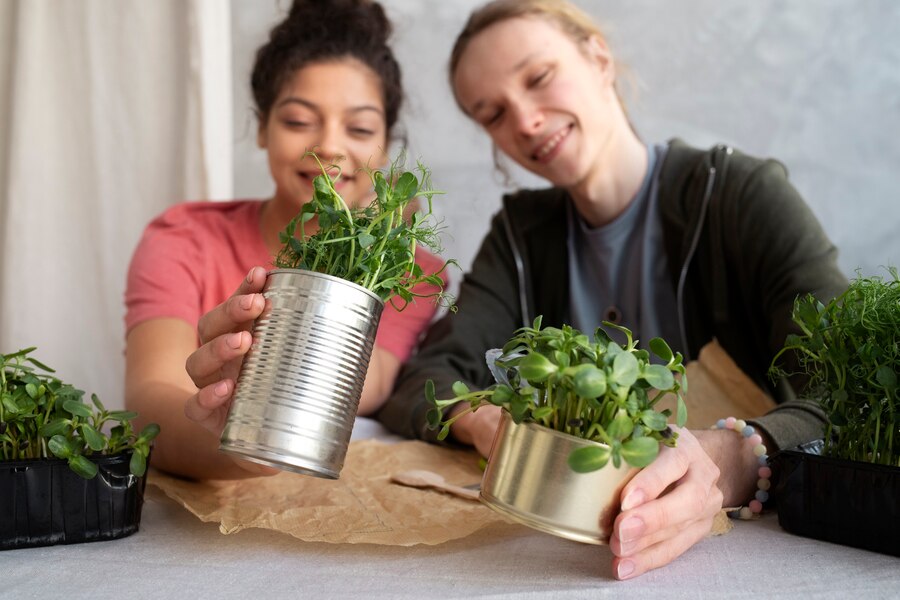Building a sustainable garden is a rewarding and environmentally friendly way to cultivate plants, beautify your outdoor space, and contribute to a greener planet. One of the most effective ways to create a sustainable garden is by using recycled materials. Not only does this approach minimize waste, but it also saves money and reduces the environmental footprint of traditional gardening methods. In this comprehensive guide, we will walk you through the key steps and strategies on how to build a sustainable garden using recycled materials, offering practical advice and up-to-date tips to make your garden a haven for both nature and sustainability.
Why Build a Sustainable Garden?
Before diving into the specifics of how to build a sustainable garden using recycled materials, let’s first explore why sustainable gardening is so important.
- Environmental Impact: Sustainable gardening practices help reduce pollution, conserve water, and protect biodiversity. By using recycled materials, you reduce the need for new resources, cutting down on production energy and waste.
- Cost-Efficiency: Recycled materials, such as old wood, bricks, and containers, are often free or significantly cheaper than buying new garden supplies. This makes it an excellent choice for gardeners on a budget.
- Waste Reduction: By repurposing items you already have at home, you can keep items out of landfills, contributing to a circular economy and reducing environmental waste.
- Biodiversity Support: Sustainable gardens encourage local wildlife, such as birds, insects, and beneficial pollinators, to thrive. This biodiversity helps maintain a balanced ecosystem and supports long-term plant health.
Step-by-Step Guide: How to Build a Sustainable Garden Using Recycled Materials
1. Planning Your Garden Layout
The first step in building any garden is planning. Think about the size and shape of your garden space, the types of plants you want to grow, and how you can incorporate recycled materials into your design.
- Design a Functional Layout: Whether you’re creating raised beds, a herb garden, or a flower bed, make sure your design maximizes sunlight exposure, minimizes water wastage, and uses recycled materials effectively.
- Consider Soil Health: Healthy soil is the foundation of any thriving garden. You can improve soil quality by incorporating compost (which you can make from food scraps) or using old cardboard as mulch to prevent weeds and conserve moisture.
2. Gathering Recycled Materials
Once you’ve planned your garden layout, it’s time to gather your materials. Here are some common recycled materials you can use in your sustainable garden:
- Old Wood: Old pallets, fencing, or wooden furniture can be repurposed into garden structures, such as raised beds, garden boxes, or trellises for climbing plants. Make sure the wood is untreated or use non-toxic paint to ensure safety.
- Plastic Containers: Reuse plastic bottles, containers, and tubs as planters. Cut them to size, create drainage holes, and fill them with soil for an eco-friendly gardening solution.
- Glass Jars and Bottles: Glass jars and bottles can be used to create unique garden lighting or small greenhouses for seedlings.
- Bricks and Stones: If you have old bricks or stones lying around, these can be used to create pathways, build garden borders, or even create a fire pit.
- Old Tires: Tires can be turned into raised beds or garden planters. Paint them in vibrant colors for a fun touch, or stack them for added height in your garden.
- Cans and Tin Containers: Empty tin cans can be used as planters, wind chimes, or garden markers. These can be creatively decorated for added charm.
3. Building Raised Beds with Recycled Materials
One of the most popular ways to use recycled materials in gardening is to build raised beds. Raised beds provide better drainage, help to prevent soil compaction, and can be made from materials like old wood, bricks, and even corrugated metal.
- Materials Needed: Old wooden pallets, scrap wood, bricks, cinder blocks, or even large plastic containers.
- Steps:
- Choose a location with plenty of sunlight.
- Lay down a weed barrier, such as cardboard, to prevent weeds from growing through the bottom of the bed.
- Assemble the materials to form a border. If you’re using bricks or cinder blocks, stack them in a rectangular shape. If you’re using wood, nail or screw the planks together to form the edges.
- Fill the raised bed with nutrient-rich soil or compost.
- Plant your desired crops and enjoy your eco-friendly garden!
4. Creating Vertical Gardens Using Recycled Materials
If space is limited, vertical gardens can be a great way to maximize your growing area. You can create vertical gardens using recycled materials such as old pallets, wine crates, and plastic bottles.
- Materials Needed: Wooden pallets, wine crates, plastic bottles, gutters, or old ladders.
- Steps:
- Find a vertical surface or wall to mount your garden.
- For pallets, simply hang the pallet upright and fill each slat with soil for planting.
- For wine crates, secure them on a wall or fence and fill them with soil for planting.
- Plastic bottles can be cut into sections and hung vertically, each holding a small plant.
Vertical gardens not only make use of recycled materials, but they also help conserve space and water, making them a sustainable option for small gardens or urban environments.
5. Water Conservation Strategies
Water is one of the most valuable resources in any garden, so it’s important to conserve it as much as possible. By using recycled materials, you can create efficient irrigation systems and water-saving techniques.
- Rain Barrels: Install a rain barrel to collect runoff water from your roof. This water can then be used to irrigate your garden.
- Greywater Systems: If you’re comfortable with a DIY project, consider setting up a greywater recycling system to reuse water from your sink, shower, or washing machine for irrigation.
- Drip Irrigation: Use recycled hoses or plastic bottles with small holes poked in them to create an inexpensive drip irrigation system.
6. Composting and Waste Reduction
Composting is a fundamental part of sustainable gardening. It allows you to recycle organic waste into valuable, nutrient-rich soil that can be used in your garden.
- Compost Bin: You can build a compost bin using wooden pallets or old chicken wire. Make sure to include a mix of green and brown materials, such as kitchen scraps, leaves, and garden trimmings.
- Vermiculture: For an eco-friendly option, consider vermiculture (worm composting) using old containers or crates.
By composting at home, you’ll reduce waste and enhance your garden soil with natural nutrients.
7. Recycling and Repurposing Garden Tools
If you have old, rusty garden tools or unused items lying around, consider repurposing them into something useful for your sustainable garden. Old shovels can be turned into garden hooks, and broken terracotta pots can be used as drainage pots or garden decorations.
Recycled Materials vs. New Materials in Gardening
| Material Type | Recycled Material | New Material | Benefits of Recycled Materials |
|---|---|---|---|
| Garden Beds | Old wood, pallets, bricks, tires | New wood, plastic, concrete blocks | Eco-friendly, cost-effective, reduces waste |
| Planters | Plastic bottles, cans, wine crates, old tires | Ceramic, terracotta, plastic planters | Low-cost, creative, reuses existing items |
| Watering Systems | Rain barrels, recycled hoses | Commercial irrigation systems | Water conservation, reuses household waste |
| Compost | Kitchen scraps, yard trimmings | Commercial compost | Reduces landfill waste, enriches soil |
Tips for Maintaining a Sustainable Garden
- Use Organic Fertilizers: Instead of synthetic fertilizers, opt for organic compost, manure, or plant-based fertilizers to nourish your garden sustainably.
- Mulch Your Garden: Use organic mulches, such as leaves, grass clippings, or newspaper (a recycled material), to reduce water evaporation, suppress weeds, and improve soil health.
- Harvest Rainwater: Install a rainwater collection system using barrels or recycled containers to capture and store rainwater for later use in your garden.
Conclusion
Building a sustainable garden using recycled materials is an excellent way to contribute to environmental conservation while enjoying the beauty of your garden. By repurposing items like old wood, plastic bottles, and tires, you can create a functional, eco-friendly outdoor space that thrives with minimal impact on the environment. Whether you’re creating raised beds, vertical gardens, or efficient watering systems, the possibilities are endless when you incorporate recycled materials into your gardening plans.










